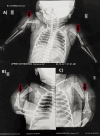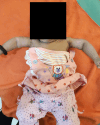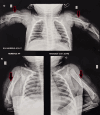Bilateral Humerus Midshaft Fracture Associated With Birth Trauma: A Case Report
- PMID: 38846241
- PMCID: PMC11153977
- DOI: 10.7759/cureus.59767
Bilateral Humerus Midshaft Fracture Associated With Birth Trauma: A Case Report
Abstract
Bilateral humerus fractures as a result of birth trauma are a rare occurrence in neonatal care, necessitating special consideration due to their potential long-term implications. Birth-related injuries involving neonatal skeletal structures, especially fractures of the humerus, require special attention and a comprehensive approach to diagnosis and management. Here, we present the case of a newborn female child who experienced bilateral humerus fractures due to birth trauma. The subsequent management involved the application of splints to immobilize the affected arms, a standard practice in the treatment of fractures.
Keywords: birth trauma; diagnosis; humerus fracture; neonatal care; splints.
Copyright © 2024, Solunke et al.
Conflict of interest statement
The authors have declared that no competing interests exist.
Figures



Similar articles
-
The epidemiology of infant shaft fractures of femur or humerus by incidence, birth, accidents, and other causes.BMC Musculoskelet Disord. 2020 Dec 11;21(1):840. doi: 10.1186/s12891-020-03856-4. BMC Musculoskelet Disord. 2020. PMID: 33308191 Free PMC article.
-
Bilateral humerus fracture following birth trauma.J Clin Neonatol. 2012 Jan;1(1):44-5. doi: 10.4103/2249-4847.92230. J Clin Neonatol. 2012. PMID: 24027686 Free PMC article.
-
Can We Stratify Quality and Cost for Older Patients With Proximal and Midshaft Humerus Fractures?Geriatr Orthop Surg Rehabil. 2021 Feb 21;12:2151459321992742. doi: 10.1177/2151459321992742. eCollection 2021. Geriatr Orthop Surg Rehabil. 2021. PMID: 33680532 Free PMC article.
-
Neonatal physeal separation of distal humerus during cesarean section.Am J Orthop (Belle Mead NJ). 2014 Nov;43(11):E279-81. Am J Orthop (Belle Mead NJ). 2014. PMID: 25379758 Review.
-
Case report and literature review anterior shoulder dislocation with three-part proximal humerus fracture and humeral shaft fracture.Iowa Orthop J. 2009;29:105-13. Iowa Orthop J. 2009. PMID: 19742096 Free PMC article. Review.
References
-
- Trends in operative vaginal delivery, 2005-2013: a population-based study. Merriam AA, Ananth CV, Wright JD, Siddiq Z, D'Alton ME, Friedman AM. BJOG. 2017;124:1365–1372. - PubMed
-
- Birth-associated femoral fractures: incidence and outcome. Morris S, Cassidy N, Stephens M, McCormack D, McManus F. https://pubmed.ncbi.nlm.nih.gov/11744849/ J Pediatr Orthop. 2002;22:27–30. - PubMed
-
- Route of delivery and neonatal birth trauma. Moczygemba CK, Paramsothy P, Meikle S, et al. Am J Obstet Gynecol. 2010;202:361. - PubMed
-
- Outcomes of vacuum-assisted vaginal deliveries of mothers with gestational diabetes mellitus. Vitner D, Hiersch L, Ashwal E, Nassie D, Yogev Y, Aviram A. J Matern Fetal Neonatal Med. 2019;32:3595–3599. - PubMed
Publication types
LinkOut - more resources
Full Text Sources
